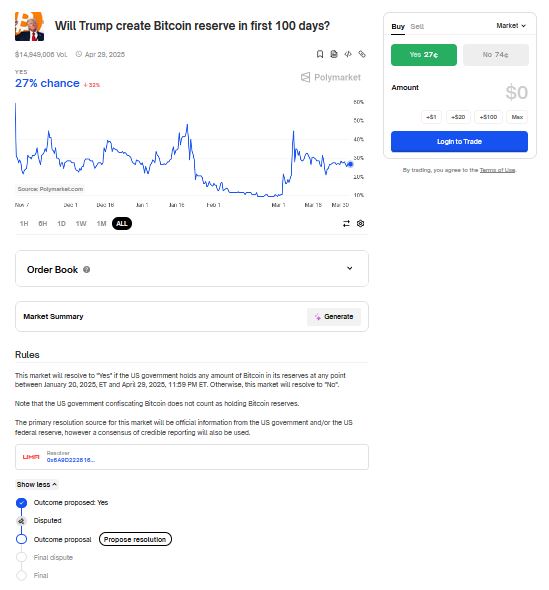The recent fallout from a $15 million prediction market on Polymarket, centered on the U.S. holding Bitcoin in its national reserves, has exposed cracks in the foundation of decentralized truth systems. Conflicting interpretations of government disclosures and reliance on oracles have left bettors divided and questioning the fairness of the outcome. As on-chain betting gains popularity, the incident raises urgent questions about how smart contracts, subjective news interpretation, and blockchain-based governance can—or cannot—coexist in a world still bound by off-chain ambiguity.
When Blockchain Truth Meets Real-World Complexity
The market at the center of the controversy is titled “Will Trump create a national Bitcoin reserve in his first 100 days?” and is hosted on Polymarket, a decentralized prediction platform allowing users to speculate on real-world events using stablecoins. The market was launched in response to political developments in the U.S., including growing crypto-friendly rhetoric from former President Donald Trump.
According to the market’s official resolution criteria, it would resolve to “Yes” only if the U.S. government holds any amount of Bitcoin in its reserves at any point between January 20 and April 29, 2025. Confiscated Bitcoin does not count. Resolution is based primarily on official documentation from the U.S. government or the Federal Reserve, and secondarily on a consensus of credible reporting.
In late March 2025, Polymarket’s data provider proposed a “Yes” outcome based on a public announcement from President Trump regarding the creation of a “Crypto Strategic Reserve.” According to the statement, the proposed reserve would include Bitcoin, Ethereum, and several other cryptocurrencies. This announcement sparked immediate debate. Some interpreted the Executive Order as confirmation that the U.S. government had begun holding Bitcoin. However, others pointed out that no documentation had been produced to confirm that the government actually acquired or added any Bitcoin to national reserves.

As of March 30, 2025, the market remains Disputed on the Polymarket platform. This status reflects the ambiguity surrounding whether the proposed reserve exists in practice or only as a policy intention. There is no final resolution.
The Oracle Challenge in Web3
At the core of this dispute is the reliability of oracles, the systems feeding off-chain data into smart contracts. Oracles are supposed to bring objective truth to decentralized systems. But in practice, objective truth becomes contested when outcomes depend on complex, nuanced developments, like government policy.
In the case of this Bitcoin Reserve prediction, the oracle responsible for resolving the market interpreted the political announcement as sufficient proof. Yet the lack of verifiable government documentation has cast doubt on whether the criteria were truly met. Smart contracts cannot function as impartial referees without clear, authoritative data.
Why It Matters to Prediction Markets
Prediction markets like Polymarket are touted as tools for gathering collective intelligence and pricing in probabilities with accuracy. But their credibility hinges on transparent resolution mechanisms. When millions of dollars are at stake, users expect outcomes to be determined not by interpretation, but by evidence.
The dispute over the Trump Bitcoin reserve prediction market has reignited calls for more decentralized and transparent oracle governance. Some in the community have proposed on-chain arbitration models, while others have pointed to services like Kleros as potential solutions for contested outcomes.
Conclusion: The Need for Better Frameworks
This unresolved and contested prediction market shows that trust and clarity matter, even in a blockchain-based system. Smart contracts are only as good as the data they consume, and the rules interpreting the data. Until oracles can resolve real-world ambiguity with provable certainty, prediction markets will continue to face the same problems they were designed to eliminate.
>>> Read more: Polymarket Faces Backlash Over TikTok Ban Bet Resolution
In Web3, the truth is programmable but still negotiable.
Readers’ frequently asked questions
What exactly is a prediction market like Polymarket, and how does it work in practice?
A prediction market is a platform where users can bet on the outcome of future events. These events could be elections, policy changes, or financial developments. Polymarket operates on the blockchain and uses USDC (a stablecoin pegged to the U.S. dollar) to let users trade shares in potential outcomes. Each market typically has a “Yes” and “No” side. The price of each share reflects the market’s belief in the likelihood of that outcome. If a share in “Yes” is trading at $0.70, the market is pricing a 70% chance of that outcome occurring. At resolution, only the correct outcome pays out at full value ($1), while the other pays nothing. The markets rely on oracles or trusted resolution criteria to determine the final outcome, which smart contracts enforce.
What is the difference between the U.S. government confiscating Bitcoin and holding it in reserves?
Confiscated Bitcoin is typically acquired through legal seizures from criminal investigations, such as taking coins from illicit marketplaces or fraud cases. These assets are not considered part of the government’s official monetary reserves. In contrast, holding Bitcoin in reserves would mean the government, through entities like the U.S. Treasury or Federal Reserve, actively and intentionally allocates part of its balance sheet to Bitcoin. The same way it does with gold or foreign currencies. This would be a formal economic decision, publicly acknowledged and documented as part of national monetary policy or asset management strategy. The key difference is intent and formal recognition.
Why can’t blockchain-based prediction markets just rely on blockchain data or code alone for resolution?
Blockchain is great for automating rules and ensuring transparency, but it can’t natively access or interpret real-world events. For example, a smart contract can’t “see” whether the U.S. government made a press release or passed legislation. A trusted external source, called an oracle, must bring it onto the blockchain. This creates a challenge when outcomes depend on nuanced real-world developments like policy decisions or public statements. While the code is deterministic, interpreting off-chain events is often not. That’s why these markets still rely on human judgment and trusted data providers for resolution. Until reliable, fully decentralized oracle systems can interpret complex real-world events with consensus, some level of subjectivity remains unavoidable.
What Is In It For You? Action Items You Might Want to Consider
Read the fine print before betting on prediction markets
Before placing capital in decentralized prediction markets like Polymarket, take a moment to study the resolution criteria in detail. Outcomes aren’t always about what feels true. They’re about what’s explicitly stated and verifiably documented. If the conditions involve government action, ask yourself: Is this provable within the time window? A trader who ignores the resolution logic risks backing the right narrative but losing the bet.
Don’t mistake hype for evidence
Sentiment can fuel token surges, like the one seen in Strategic Bitcoin Reserve (SBR). But that doesn’t mean the fundamentals have shifted. If you’re trading on market momentum tied to prediction events or political rumors, make sure you separate narrative speculation from facts. Use these moments for short-term plays only if you’re clear-eyed about the underlying risks.
Watch for future oracle upgrades or governance changes
The Polymarket dispute exposes real friction in how decentralized systems resolve off-chain events. Keep an eye on whether platforms like Polymarket adopt new arbitration mechanisms or integrate more transparent oracle frameworks. If you’re active in these markets, staying ahead of governance proposals or dispute resolution upgrades could give you a tactical edge in future trades.










